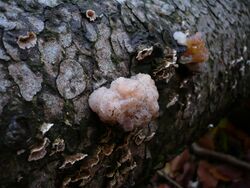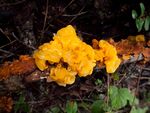Biology:Naematelia
| Naematelia | |
|---|---|

| |
| Gelatinous fruit body of Naematelia encephala with its host Stereum sanguinolentum | |
| Scientific classification | |
| Domain: | Eukaryota |
| Kingdom: | Fungi |
| Division: | Basidiomycota |
| Class: | Tremellomycetes |
| Order: | Tremellales |
| Family: | Naemateliaceae |
| Genus: | Naematelia Fr. |
| Type species | |
| Naematelia encephala (Pers.) Fr.
| |
| Synonyms | |
| |
Naematelia is a genus of fungi in the family Naemateliaceae. All Naematelia species are parasites of other fungi (Stereum species) and produce anamorphic yeast states. When produced, Basidiocarps (fruit bodies),, are gelatinous and are colloquially classed among the "jelly fungi."Four species of Naematelia are currently recognized worldwide. One species, Naematelia aurantialba, is commercially cultivated for food.
Taxonomy
History
Naematelia was introduced in 1816 by Elias Magnus Fries for fungal fruit bodies with a gelatinous outer layer and a hard inner core, as in the type species Naematelia encephala. Some mycologists subsequently used the name, while others considered Naematelia synonymous with Tremella since its basidia were Tremella-like.[1] In a 1961 paper, American mycologist Robert Bandoni showed that the hard inner core of Naematelia encephala was composed largely of host tissue (Stereum sanguinolentum) and that Naematelia, therefore, represented no more than a Tremella species and its host.[1]
However, molecular research, based on cladistic analysis of DNA sequences, has shown that Tremella is polyphyletic (and hence artificial).[2][3][4][5]
Therefore, a different generic name was required for a group of species not closely related to Tremella mesenterica (the type species of Tremella), and in 2015 Naematelia was selected as the earliest such name available. Comparatively few species, however, has yet to be sequenced.[6]
Description
Fruit bodies are gelatinous (but may have a hard inner core mainly composed of host hyphae) and are variously cephaliform (like a brain, with folds and ridges), lobed, or foliose (with leaf-like or seaweed-like fronds). Colors are typically pinkish, ochraceous, yellow, or brown.
Microscopic characters
Naematelia species produce clamped hyphae and have haustorial cells from which hyphal filaments seek out and penetrate the hyphae of the host. The basidia are "tremelloid" (globose to ellipsoid, sometimes stalked, and vertically or diagonally septate), giving rise to long, sinuous sterigmata or epibasidia on which the basidiospores are produced. These spores are smooth, globose to ellipsoid, and germinate by hyphal tube or yeast cells. Conidiophores are often present, producing conidiospores that are similar to yeast cells.[2][7]
Habitat and distribution
Species are parasitic on fruit bodies of Stereum species that grow on dead attached or fallen wood. Hosts include Stereum hirsutum on broadleaf trees and Stereum sanguinolentum on conifers.
As a group, Naematelia species occur worldwide, though individual species may have a more restricted distribution.
Species and hosts
| Image | Name | Distribution | Host |
|---|---|---|---|
 |
Naematelia aurantia | Asia, Australasia, Europe, North & South America | Stereum hirsutum[8] |
| Naematelia aurantialba | China | Stereum hirsutum[9] | |
 |
Naematelia encephala | Asia, Australasia, Europe, North America | Stereum sanguinolentum[10] |
| Naematelia microspora | South Africa | Stereum species |
References
- ↑ 1.0 1.1 Bandoni RJ. (1961). "The genus Naematelia". American Midland Naturalist 66 (2): 319–328. doi:10.2307/2423032.
- ↑ 2.0 2.1 Chen C-J. (1998). Morphological and molecular studies in the genus Tremella. Berlin: J. Cramer. pp. 225. ISBN 978-3-443-59076-5.
- ↑ "Biodiversity and systematics of basidiomycetous yeasts as determined by large-subunit rDNA D1/D2 domain sequence analysis". International Journal of Systematic and Evolutionary Microbiology 50 (3): 1351–1371. 2000. doi:10.1099/00207713-50-3-1351. PMID 10843082. http://ijs.sgmjournals.org/cgi/reprint/50/3/1351.pdf. Retrieved 2010-04-21.
- ↑ "New taxa in the Tremellales: Bulleribasidium oberjochense gen. et sp. nov., Papiliotrema bandonii gen. et sp. nov. and Fibulobasidium murrhardtense sp. nov". Mycologia 94 (5): 873–887. 2002. doi:10.2307/3761703. PMID 21156562.
- ↑ "Phylogeny and Phenotypic Characterization of Pathogenic Cryptococcus Species and Closely Related Saprobic Taxa in the Tremellales". Eukaryotic Cell 8 (3): 353–361. 2009. doi:10.1128/EC.00373-08. PMID 19151324. PMC 2653247. http://run.unl.pt/bitstream/10362/4019/1/Fonseca_2009.pdf.
- ↑ "Towards an integrated phylogenetic classification of the Tremellomycetes". Studies in Mycology 81: 85–147. 2015. doi:10.1016/j.simyco.2015.12.001. PMID 26955199.
- ↑ "Mycoparasitism of some Tremella species". Mycologia 86 (1): 49–56. 1994. doi:10.2307/3760718.
- ↑ Roberts P. (1995). "British Tremella species I: Tremella aurantia and T. mesenterica". Mycologist 9 (3): 110–114. doi:10.1016/S0269-915X(09)80270-X.
- ↑ "On an undescribed Tremella from China". Mycologia 82 (2): 270–273. 1990. doi:10.2307/3759859.
- ↑ Roberts P. (1999). "British Tremella species II: T. encephala, T. steidleri & T. foliacea". Mycologist 13 (3): 127–131. doi:10.1016/S0269-915X(99)80044-5.
Wikidata ☰ Q27863232 entry
 |

